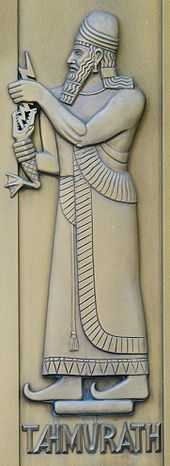Tahmuras

Tahmuras or Tahmures (Persian: طهمورث), New Persian transliteration Ṭahmūraṯ, older Persian Tahmurat or Tahmurath, from Avestan Taxma Urupa, is the third Shah of the world according to Ferdowsi's epic poem, the Shahnameh. He is considered as the builder of Merv. There is no evidence for his existing as an earlier Aryan chief.
Tahmuras in the Shahnameh
Tahmuras was the son of Hushang. In his time the world was much troubled by the demons of Ahriman. On the advice of his vizier Šaydāsp (شیداسپ), Tahmuras used magic to subdue Ahriman and made him his slave, even riding upon his back as on a horse. The demons rebelled against Tahmuras, and he made war against them with both magic and force. By magic he bound two-thirds of the demons; the remaining third he crushed with his mace. The race of divs now became Tahmuras's slaves, and they taught him the art of writing in thirty different scripts.
Like his father, Tahmuras was a great inventor of arts for easing the human condition. He invented the spinning and weaving of wool, learned to domesticate chickens, how to store up fodder for livestock instead of merely grazing them, and how to train animals like dogs and falcons to hunt for people.
Tahmuras ruled for thirty years and was succeeded by his son Jamshid.
Erection of Shiraz
Based on some Iranian traditions, the Shiraz city was originally erected by Tahmuras Diveband.[1] It has been said by some of the native writers that the name Shiraz has derived from the name of Tahmuras's son.[2]
| Preceded by Hushang |
Legendary Kings of the Shāhnāma 70-100 (after Keyumars) |
Succeeded by Jamshid |
References
External links
- A king's book of kings: the Shah-nameh of Shah Tahmasp, an exhibition catalog from The Metropolitan Museum of Art (fully available online as PDF), which contains material on Tahmuras